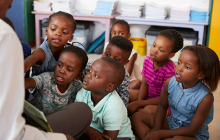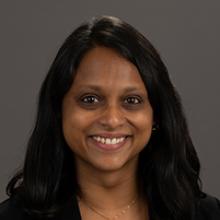Meet the Expert: Pooja Reddy Nakamura

Pooja Reddy Nakamura has experience overseeing a portfolio of projects on foundational learning in over 20 countries. She focuses on understanding how early literacy is acquired in complex, multilingual contexts. Previously, she taught in a variety of settings, including teaching English to preschool children in urban poor communities in India and English as a second language to high school students in Japan.
POSITION: Principal Researcher
AREAS OF EXPERTISE: Foundational learning and multilingual education
YEARS OF EXPERIENCE: 17
Q: What piqued your interest in a career in literacy development and the developing world?
Pooja: I’ve always been fascinated by language. When I was growing up in Bangalore, India, I had nearly unlimited access to books, and the joy that reading brings. But I soon learned my access to this joy stemmed from my ability to read in English.
For millions of children across the world, reading is a distant dream. There are many reasons for this, but a critical one is language. Children often lack reading materials in their own language or languages; sometimes they lack teachers to teach those languages. But most importantly, deeply entrenched systems that drive education access and socioeconomic mobility are tied to literacy in the language of power, the postcolonial language—most often English. There's been a shift toward more local language literacy programs across the world, but complexities and inequities persist throughout low- and middle-income countries.
Q: What evidence-based approaches are governments using to improve national literacy?
Pooja: Recent evidence on learning to read in low- and middle-income countries points to a few key ingredients for success. The first is teaching children in languages they understand. This may sound like a no-brainer, but shockingly, almost 37% of children in low- and middle-income countries are educated in languages they do not use or understand.
Most children across the world grow up multilingual, yet most research on the science of learning to read comes from monolingual models of alphabetic reading—specifically, English. When utilized well—through an additive bilingual program—multilingualism facilitates language learning.
The second ingredient is meeting the child and the teacher where they are. In low- and middle-income countries, teachers often work with very limited resources. Sometimes they teach large classrooms of 50 or 60 children, with multiple ages and levels. In these situations, teachers need simple, structured ways to assess their students’ reading levels and determine how best to support them.
The third piece to enacting a successful, large scale reading program is implementing it within the country’s existing educational infrastructure. The program should be completely owned by the government and implementers of that program. With that in mind, we developed the Foundational Literacy Improvement Package, or FLIP. It’s a toolkit that allows teachers to assess their students’ reading levels and use that data to adjust their teaching practices. So, for example, teachers in Benin use data to group their students into levels, and will adjust their teaching practices to those level to maximize effective learning. In addition, FLIP offers a host of evidence-based teaching tools for a variety of multilingual contexts. For example, we have phonics games tailored to the script of that language, and bilingual materials to support learning in two or more languages.
We have pretty strong evidence around how these tools have supported literacy in Laos and bilingual literacy in Guatemala; we're currently implementing and testing the model at scale in Benin and Lesotho as well. We’ve covered four very different pockets of the world, because we want to prove that this model has universal components that are applicable across complex linguistic environments in low- and middle-income countries.
Q: Though much of it is universal, FLIP is also designed to be customized to local contextual needs. Can you share an example of how that has worked in practice?
Pooja: This customization happens at many levels. One possibility is customizing the program around a language’s particular writing system. There are different writing systems across the world: for example, most alphabetic languages—the ones used in most of Latin America, sub-Saharan Africa, Europe, and North America—use the Roman alphabet, or some version of it. That requires learning some 20-60 characters. On the other hand, in South Asia and Southeast Asia, they use alpha-syllabic scripts, which require learning between 200 to 500 symbols. And then, in East Asia, the languages require learning between 3,000 to 10,000 symbols or characters. Obviously, reading programs will look different based on these and other writing system differences. That’s just one example, of course—we also customize based on culture, geographies, other language variations, and so on.
Q: One of your areas of expertise is complex multilingual environments. How does the presence of multiple languages complicate or enhance literacy learning? Does the similarity of the languages (for example, a shared alphabet) play a role?
Pooja: Most children across the world grow up multilingual, yet most research on the science of learning to read comes from monolingual models of alphabetic reading—specifically, English. When utilized well—through an additive bilingual program—multilingualism facilitates language learning.
In recent AIR studies, we’ve found an inflection point, after which the child has gained sufficient reading language skill in one language to transfer it to the second. This is a very valuable finding from a policy perspective—it helps us understand when teachers can, and should, introduce a second (or later learned) language. If teachers attempt to incorporate a second language before that inflection point, the children are likely to fail reading in both languages. That inflection point varies based on similarity of the two languages’ scripts, the child’s level of mastery in each language, the status of each language in the society, and so forth. But here’s the critical takeaway: No matter how different the languages are, multilingualism is a powerful resource for learning in a well-designed literacy program. That is a foundational principle in FLIP.
Q: What makes a literacy program sustainable over the long term?
Pooja: The real answer is that I don’t know! If we knew, there would be more successful, sustainable programs.
There are some things we do know, of course. We have to go slow to go far. Unfortunately, incremental change is not always politically palatable, but it is necessary to build rigorous, multidisciplinary research over time. Another key component of sustainability is stakeholder buy-in and ownership of the program. The local educational leaders need to see the project as truly theirs, and they have to want the project to succeed on their own terms.
Q: Where can we find you on a typical Saturday?
Pooja: Taking my six- and eight-year-old kids to Japanese school, probably before or after a long run or swim. My husband is Japanese, and we’re raising our children bilingually in English and Japanese—with some Telugu just for fun.
Q: What book would you recommend to anyone?
Pooja: There is no single book that I would recommend to anyone, because I think recommendations should be tailored to individuals. Everyone should reach for books that were originally written in unfamiliar languages, from unfamiliar places, and perhaps those that force us to challenge our beliefs. Three examples that come to mind for me are Flowers for Algernon by Daniel Keyes, The Wind-up Bird Chronicle by Haruki Murakami, and The Coddling of the American Mind by Jonathan Haidt and Greg Lukianoff.

